2. 复旦大学附属中山医院肾内科 上海 200032;
3. 上海市肾病与透析研究所 上海 200032
2. Department of Nephrology, Zhongshan Hospital, Fudan University, Shanghai 200032, China;
3. Shanghai Institute for Kidneys and Dialysis, Shanghai 200032, China
局灶节段性肾小球硬化症(focal segmental glomerulosclerosis,FSGS)是一种以肾小球局灶节段性硬化和足细胞足突广泛融合消失[1]为病理特征的慢性肾小球疾病。临床上,FSGS以大量蛋白尿或肾病综合征为主要表现,约40%的成人肾病综合征和20%的儿童肾病综合征由FSGS造成[2-3]。大多数FSGS患者对激素治疗不敏感,预后较差,是进展至终末期肾病的重要疾病之一[4]。目前认为足细胞损伤(骨架异常、肥大、自噬、脱落和凋亡等)是引起FSGS改变的重要机制[5-8]。由于足细胞是高度分化成熟的细胞,其发生凋亡后常不能迅速或难以被修复,是引起足细胞数量减少的重要原因,更是造成肾小球基膜裸露、大量蛋白尿的重要机制,也因此与FSGS的难治性紧密相关[9]。所以,如何抑制或延缓足细胞凋亡是阻止FSGS进展和肾硬化发生的关键因素。
Hippo-YAP通路是新近备受关注的可调控细胞增殖和凋亡的信号传导通路[10]。通路上游蛋白Mst1/2经多种因素激活后可磷酸化Lats1/2,Lats1/2进一步磷酸化下游效应蛋白YAP/TAZ[11]。磷酸化的YAP留在细胞浆内[12-14],部分通过泛素蛋白酶体途径降解[15-16],近年研究发现部分YAP还可通过自噬经溶酶体途径降解[17-19];非磷酸化的YAP能入核内与TEAD1-4等结合,起到辅助转录因子的作用来抑制细胞凋亡,促进细胞增殖[20-21]。因此,Hippo-YAP通路是调节细胞凋亡和生长的重要通路,它与疾病的关系近年来也越来越受到关注,已有不少文献报道Hippo-YAP通路的异常与多种肿瘤的发生发展密切相关并可能是潜在的治疗靶点[22-24]。
Hippo-YAP通路与肾病相关性的研究刚处于起步阶段。有文献报道YAP/TAZ的缺失或表达异常与肾脏的发育以及多囊肾的形成相关[25-26]。近来,Schwartzman等[27]在足细胞特异性YAP敲除的转基因小鼠中,观察到肾小球内局灶节段性硬化灶的形成和肾功能的下降,提示YAP的缺失与足细胞损伤相关;国内有课题组使用体外培养的足细胞观察到了与骨架蛋白密切相关的RhoA及Cdc42的缺失可通过抑制Hippo-YAP通路而促进足细胞凋亡[28-29]。以上研究提示,Hippo-YAP通路异常与足细胞的凋亡及FSGS的形成关系十分密切。本团队在前期工作中发现了YAP出核是导致FSGS中足细胞凋亡的重要机制[30],但FSGS中YAP的出核是否能被逆转,且YAP核质定位的逆转能否减少足细胞凋亡,从而延缓FSGS的疾病进程仍未可知。
本研究收集了人FSGS肾穿标本,构建了阿霉素诱导的FSGS小鼠模型和阿霉素诱导的体外足细胞损伤模型,并使用RNA干扰YAP表达或YAP激动剂1-油酰基溶血磷脂酸(1-Oleoyl lysophosphatidic acid,LPA)处理等手段,探讨了YAP与FSGS中足细胞凋亡的相关性及其激动剂的作用,以期为FSGS的防治提供新靶点和新策略。
材料和方法抗体 兔抗YAP抗体(14074s)、兔抗p-YAP(Ser397)抗体(13619s)、兔抗p-YAP(Ser127)抗体(13008s)、兔抗Cleaved Caspase-3抗体(9661s)购于美国Cell Signaling Technology公司;兔抗YAP1抗体(13584-1-AP)、鼠抗β-Actin抗体(66009-1-Ig)、兔抗Histone-H3抗体(17168-1-AP)、兔抗SYNPO抗体(21064-1-AP)、辣根过氧化物酶标记的羊抗兔IgG(PI-1000-1)、马抗兔IgG DyLight594(DI-1094)、马抗鼠IgG DyLight488(DI-2488)购于美国Vector Laboratories公司。
人体样本 癌旁肾组织为复旦大学附属肿瘤医院病理科提供;人FSGS肾活检组织为复旦大学基础医学院病理学系肾病实验室经免疫荧光、光镜及电镜确诊的临床肾穿刺病例。人体样本实验已由复旦大学基础医学院人体伦理委员会批准(批准号:[2017]伦研第(008)号)。
动物实验 实验用C57BL/6小鼠购置于上海斯莱克实验动物有限责任公司。实验起讫时间为2020年9月至2022年9月。选取10只雄性小鼠在其8周龄时进行单侧肾脏切除手术,后将小鼠继续饲养至12周龄,将经过单肾切手术的小鼠完全随机化平均分配到实验组及对照组(各5只),实验组小鼠以17 mg/kg剂量[30]单次尾静脉注射阿霉素(美国Sigma公司),对照组小鼠以相同剂量单次尾静脉注射阿霉素溶剂双蒸水(vehicle),继续饲养8周后对小鼠实施安乐死;另取10只雄性小鼠按照上述相同操作在其8周龄时进行单侧肾脏切除手术,饲养至12周龄时将全部小鼠经尾静脉单次注射阿霉素(17 mg/kg),继续将小鼠饲养至15周龄,将注射了阿霉素的小鼠完全随机化平均分配到实验组及对照组(各5只),实验组小鼠以1 mg/kg剂量腹腔注射LPA(英国Tocris Bioscience公司),每2天1次,连续注射5周,对照组小鼠以相同剂量、相同频率腹腔注射LPA溶剂PBS(vehicle),待小鼠饲养至20周龄时对小鼠实施安乐死。所有实验动物的处理均符合动物伦理要求,并获得复旦大学基础医学院实验动物伦理委员会批准(批准号:20170223-046)。
小鼠肾功能检测 收集小鼠尿液,对小鼠实施安乐死后收集小鼠血液,按照小鼠尿白蛋白、尿肌酐、血清肌酐、尿素氮定量试剂盒(南京建成生物工程研究所)说明书检测小鼠肾功能。
碘酸雪夫染色、免疫组化染色和免疫荧光染色 碘酸雪夫染色(PAS)、免疫组化染色(IHC)和免疫荧光染色(IF)实验方法参考文献[31-32]。IHC及IF所使用的一抗有YAP(1∶100稀释)、SYNPO(1∶100稀释)和Cleaved Caspase-3(1∶50稀释),IHC中石蜡切片二抗孵育完成后使用DAB染色液(丹麦Dako公司)显色。PAS及IHC实验切片封片后于光学显微镜下拍照(日本Nikon公司,Eclipse Ci),IF实验切片封片后于荧光显微镜下拍照(德国Zeiss公司,Axio Scope)。
细胞培养 条件永生化小鼠足突细胞株(podocyte)由美国哈佛大学麻省总院Peter Mundel博士惠赠。细胞贴壁生长,使用含10%胎牛血清(美国Gibco公司)和1%的双抗(青霉素/链霉素)PRMI1640(美国Gibco公司)培养基,置于37 ℃、5% CO2培养箱中培养,细胞生长至90%~95%融合时传代。
阿霉素或LPA处理细胞 处理前1天,以每孔3×105个细胞的密度接种于6孔板中,将阿霉素以1 μg/mL剂量分别处理细胞0、2、4、6及8 h或将LPA以1 μmol/L剂量处理细胞12 h,处理完成后回收细胞并提取蛋白。
RNA干扰 处理前1天,以每孔3×105个细胞的密度接种于6孔板中,待细胞生长至50%~60%融合时更换新鲜的培养基。根据转染试剂说明书配置转染复合物,取2个无菌1.5 mL EP管各加100 μL 1×转染缓冲液(由DEPC水与转染试剂配套的5×转染缓冲液配制),并依次各加入5 μL浓度为10 μmol/L的阴性对照siRNA或YAP-siRNA,轻轻涡旋振荡混匀,室温静置5 min;每个EP管各加入4 μL GenMute siRNA转染试剂(美国SignaGen Laboratories公司),轻柔混合均匀后室温静置15 min,形成转染复合物;将转染复合物分别加入6孔板各孔中,轻柔混合均匀,继续培养48 h后回收细胞并提取蛋白。YAP siRNA:5’-CGAGAUGAG-AGCACAGACA-3’。YAP siRNA由上海吉满生物科技有限公司设计并合成。
核质分离蛋白提取 待细胞处理完成后,按照核质分离试剂盒(美国赛默飞公司)说明书提取细胞核浆蛋白。
Western blot实验 实验方法参考文献[31-32],简述如下:弃去细胞培养基,加入细胞裂解液冰上裂解细胞提取蛋白,所获蛋白经SDS-PAGE胶(8%~12%)电泳后转移至PVDF膜,经10%脱脂奶粉封闭后依次加入一抗和二抗,再由ECL化学发光法进行检测,以β-actin为内参进行分析。
Hoechst 33258染色 处理前1天,以每孔1.5×105个细胞的密度接种于放置有直径为20 mm细胞爬片的12孔板中;待细胞处理完毕后,将甲醇和冰醋酸以3∶1的比例混合后4 ℃预冷,固定细胞10 min;PBS浸洗细胞3 min×3次;加入Hoechst 33258染色液(碧云天生物技术公司)避光染色5 min,Hoechst 33258是一种可以穿透细胞膜的蓝色荧光染料,在嵌入双链DNA后释放强烈的蓝色荧光,正常细胞核染色后呈圆形或椭圆形的蓝色,而凋亡细胞的细胞核出现核固缩或核碎裂,经染色后呈现明亮的亮蓝色;染色结束后使用缓冲甘油封片,于荧光显微镜下观察足细胞凋亡情况并随机选取10个视野拍照,采用Image J软件进行计数并计算凋亡率,即每个视野中亮染的凋亡细胞核占视野中所有细胞核的比例。
统计学方法 所有检测的实验指标数值以x±s表示,每个实验均为重复3次以上的独立实验,统计分析采用GraphPad Prism 9.3,两组间的比较使用t检验分析,多组间比较采用单因素方差分析(ANOVA),t值和F值越大,对应的P值越小,则结果越显著。P<0.05为差异有统计学意义。
结果FSGS小鼠模型的建立 将经过单肾切除手术的10只小鼠完全随机化平均分配到实验组及对照组(每组5只),实验组小鼠经尾静脉单次注射阿霉素以构建FSGS模型,对照组小鼠经尾静脉单次注射阿霉素溶剂双蒸水(vehicle),8周后对所有小鼠实施安乐死。结果发现,与对照组小鼠相比,实验组小鼠肾小球中出现大量节段性硬化或球性硬化(图 1A);生化检测发现,实验组小鼠血尿素氮(t=3.702,P=0.020 8)、血肌酐(t=2.983,P=0.040 6)和尿白蛋白/肌酐比(t=4.386,P=0.002 3)较对照组小鼠明显升高(图 1B~1D)。以上结果提示,阿霉素诱导所致FSGS小鼠模型构建成功。
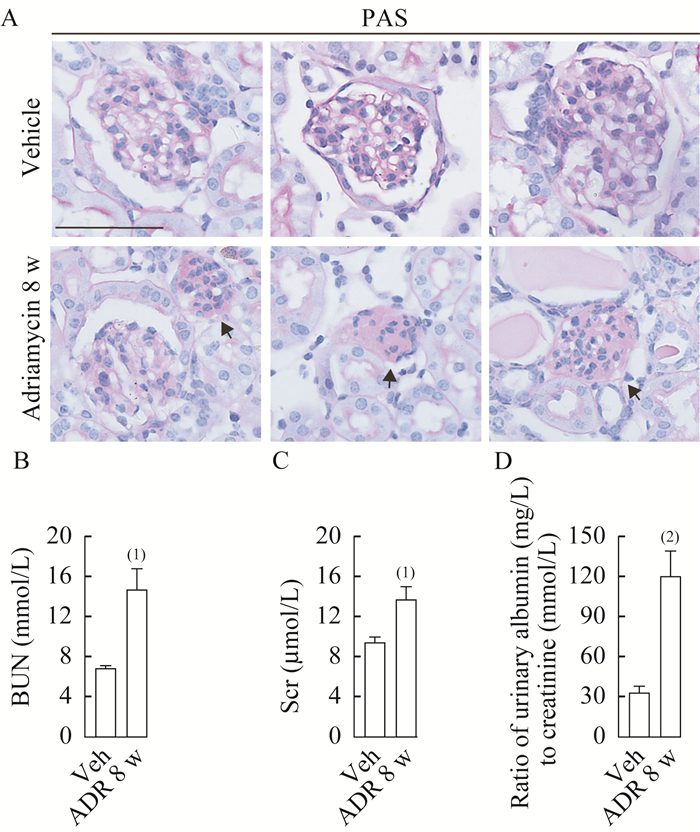
|
| A: PAS staining indicated global glomerulosclerosis (black arrows) in adriamycin-induced FSGS mice (scale bar: 50 μm); B-D: Adriamycin group compared with vehicle group. (1)P < 0.05, (2)P < 0.01. BUN: Blood urea nitrogen; Scr: Serum creatinine. 图 1 阿霉素诱导所致FSGS小鼠模型肾小球形态和肾功能变化 Fig 1 Glomerular morphology and changes in renal function of adriamycin-induced FSGS mice model |
FSGS中足细胞凋亡增多 选取5例经我系病理诊断为FSGS的患者肾穿标本及3例人癌旁正常肾脏组织标本,经IHC染色后发现,癌旁肾组织的足细胞中Cleaved Caspase-3的表达为阴性,而FSGS患者足细胞中Cleaved Caspase-3的表达明显升高(图 2A);FSGS模型小鼠足细胞中Cleaved Caspase-3的表达同样较对照组明显升高(图 2B);使用阿霉素处理体外培养的足细胞0、2、4、6及8 h后经Western blot检测发现,8 h时Cleaved Caspase-3的蛋白表达明显上升(F=34.09,P<0.000 1)(图 2C),Hoechst 33258染色结果同样表明阿霉素处理8 h时的足细胞凋亡率较未处理组明显升高(F=126.5,P<0.000 1)(图 2D),差异具有统计学意义。以上结果共同提示,在体内和体外FSGS中足细胞凋亡增多。
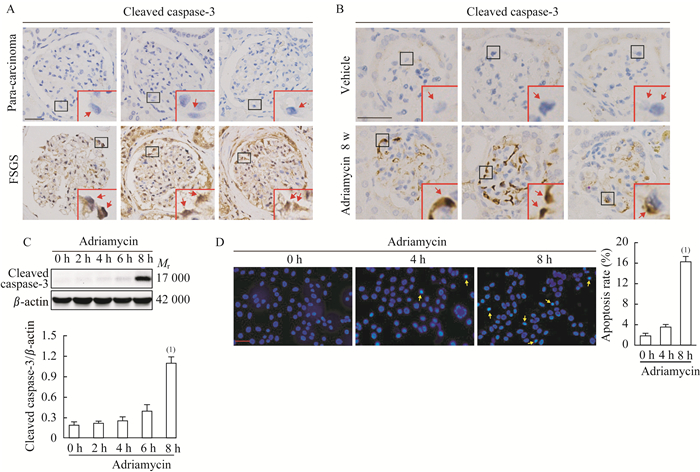
|
| A-B: Representative immunohistochemical staining for cleaved Caspase-3 images from para-carcinoma tissue (n=3) and FSGS patients (n=5) (A), or from control mice and mice treated with adriamycin (n=5) (B), and representative positive cleaved Caspase-3 stained podocytes were marked with arrow (scale bar: 40 μm); C: Western blot showed protein expression of cleaved Caspase-3 in podocytes treated with adriamycin in vitro; D: Podocytes apoptosis was detected by Hoechst 33258 staining and apoptotic cells were brightly stained (yellow arrows, scale bar: 25 μm). (1) vs. 0 h, P < 0.000 1. 图 2 FSGS中足细胞凋亡增多 Fig 2 Apoptotic podocytes increased in FSGS |
FSGS足细胞中YAP出核明显 为探究足细胞中YAP表达与细胞凋亡间的关系,使用YAP与足细胞标志蛋白SYNPO的免疫荧光双染色检测人与小鼠FSGS足细胞中YAP的表达。结果显示,在人癌旁肾组织与对照组小鼠中,YAP均匀分布于足细胞的细胞核及胞浆内;而在FSGS患者及模型小鼠足细胞中,YAP则主要分布于胞浆(图 3A-B)。进一步使用Western blot检测经阿霉素处理的足细胞总蛋白及核质分离后核、浆蛋白,结果显示,核内YAP的表达在阿霉素处理前期短暂升高,后逐渐降低(F=73.22,P<0.001),而胞浆内YAP则在阿霉素处理后一直呈现表达显著升高(F=30.50,P=0.003 2)(图 3C);足细胞总蛋白中,总YAP的表达无明显变化(F=1.722,P=0.221 2),定位于胞浆的p-YAP(S127)的表达在4 h时升高,而后回落至基线水平(F=5.102,P=0.016 8),p-YAP(S397)的表达在4 h后持续升高(F=5.643,P=0.012 2),且[p-YAP(S127)+p-YAP(S397)]/总YAP的比例也在4 h后持续升高(F=12.83,P<0.001)(图 3D),说明可入核的非磷酸化YAP减少。以上结果提示,FSGS足细胞中YAP出核越多,细胞凋亡越多。

|
| A-B: Double immunofluorescence staining with YAP and SYNPO revealed the distribution of YAP in podocytes from para-carcinoma tissue (n=3) and FSGS patients (n=5) (A, scale bar: 50 μm), or from control mice and mice treated with adriamycin (n=5) (B, scale bar: 20 μm), arrows point out podocytes stained with YAP; C: Western blot examined YAP expression in nuclear or cytoplasm protein from the adriamycin-induced podocytes, and the level of nuclear histone protein was used as an internal standard, β-actin was used as an internal reference for cytoplasm protein; D: Western blot examined protein expression of p-YAP(S127), p-YAP(S397) and YAP in cultured podocytes induced by adriamycin. vs. 0 h, (1)P < 0.05, (2)P < 0.01; ns: Not significant. 图 3 FSGS足细胞中YAP出核 Fig 3 YAP exhibited nucleus exclusion in podocytes of FSGS |
YAP激动剂LPA可改善阿霉素诱导所致FSGS小鼠模型的肾脏形态和肾功能 将8周龄时经过单肾切手术的10只小鼠全部于12周龄时经尾静脉单次注射阿霉素,随后完全随机化平均分配到实验组及对照组(每组5只),实验组小鼠在尾静脉注射阿霉素3周后腹腔注射YAP激动剂LPA,每2天1次,对照组小鼠以相同剂量、相同频率腹腔注射LPA溶剂PBS(vehicle),在实验组及对照组小鼠连续注射5周后对所有小鼠实施安乐死。与对照组小鼠相比,实验组小鼠经LPA处理后肾小球球性硬化和节段性硬化减少,系膜细胞增生和基质增多得到明显改善,且肾小球毛细血管襻与球囊壁的节段粘连明显减少(图 4A),节段粘连肾小球占全部肾小球的比例较对照组小鼠明显减少(t=17.68,P<0.000 1)(图 4B)。进一步生化检测发现,实验组小鼠的血尿素氮(t=4.576,P=0.010 2),尿白蛋白/肌酐(t=2.51,P=0.045 6)较对照组小鼠明显降低(图 4C和图 4E),血肌酐较对照组小鼠无明显差异(t=1.553,P=0.195 5)(图 4D)。以上结果提示LPA可改善阿霉素诱导所致FSGS小鼠模型的肾脏形态和肾功能。
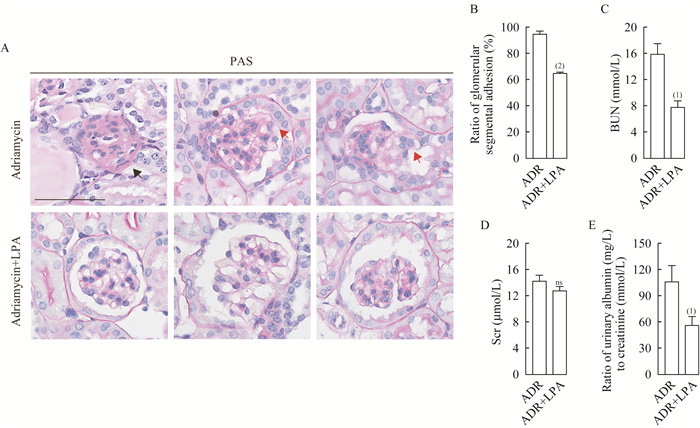
|
| A: PAS staining indicated global glomerulosclerosis (black arrows) and glomerular segmental adhesion (red arrows) in adriamycin-induced FSGS mice (scale bar: 50 μm); B: The number of glomeruli with segmental adhesions and the total number of glomeruli in each PAS-stained section were observed and recorded, the proportion of glomeruli with segmental adhesion to the total glomeruli is the ratio of glomerular segmental adhesion; C-E: Measurements of BUN, Scr and ratio of urinary albumin to creatinine in adriamycin group after LPA treatment. vs. control group, (1)P < 0.05, (2)P < 0.000 1. Blood urea nitrogen; Scr: Serum creatinine; ns: Not significant. 图 4 LPA可改善阿霉素诱导所致FSGS小鼠模型的肾小球形态和肾功能 Fig 4 LPA improved the glomerular morphology and renal function of Adriamycin-induced FSGS mice model |
YAP激动剂LPA减少阿霉素所致的足细胞凋亡 为进一步探究激活YAP能否抑制足细胞凋亡,我们检测了FSGS模型小鼠经LPA处理5周后足细胞中YAP的表达及足细胞凋亡,LPA通过抑制细胞质中YAP与14-3-3的结合进而抑制YAP S127位点的磷酸化,促使YAP入核,从而激活YAP[33]。经YAP与SYNPO的免疫荧光双染色后发现,FSGS模型小鼠足细胞中YAP主要分布于胞浆,核内表达很少,而经LPA处理后足细胞中核内YAP表达明显增多(图 5A);经IHC染色后发现,与未处理组小鼠相比,FSGS模型小鼠经LPA处理后足细胞中Cleaved Caspase-3的表达明显降低(图 5B);我们进一步在体外使用LPA处理经阿霉素诱导的足细胞损伤模型,使用Western blot检测经LPA处理后的足细胞总蛋白及核质分离后核、浆蛋白,结果显示,阿霉素诱导的足细胞损伤模型经LPA处理后,核内YAP表达升高(t=5.438,P=0.005 6),胞浆内YAP表达降低(t=4.308,P=0.012 6)(图 5C),YAP入核;足细胞总蛋白中,与对照组相比,足细胞经LPA处理后,p-YAP(S127)表达降低(t=5.241,P=0.006 3),p-YAP(S397)的表达无明显变化(t=0.155 2,P=0.884 2),总YAP表达升高(t=4.550,P=0.010 4),且[p-YAP(S127)+p-YAP(S397)]/总YAP的比例降低(t=8.365,P=0.001 1),Cleaved Caspase-3的表达明显降低(t=8.954,P<0.001)(图 5D);对足细胞使用Hoechst 33258染色后,随机选取10个视野进行计数并计算凋亡率(ImageJ软件),结果显示,经LPA处理后足细胞凋亡率明显降低(t=10.3,P<0.001)(图 5E)。以上结果提示,LPA可通过促进YAP入核激活YAP,从而减少阿霉素诱导所致的足细胞凋亡。
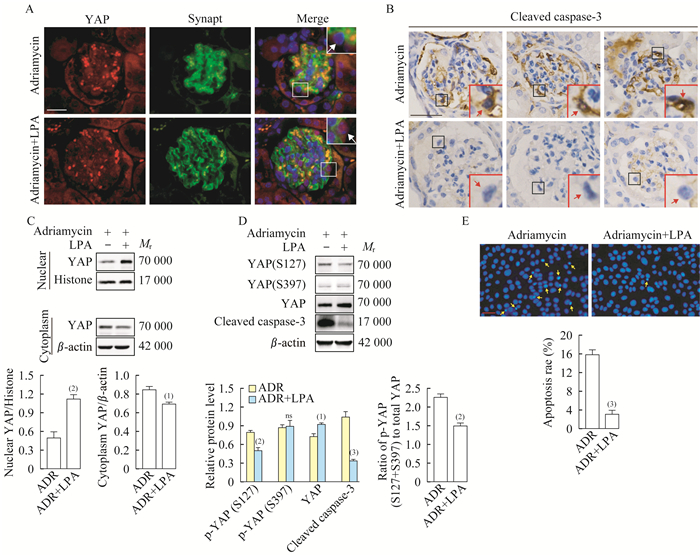
|
| A: Double immunofluorescence staining with YAP and SYNPO revealed the distribution of YAP in podocytes (arrows) from adriamycin-induced FSGS mice model and that model treated with LPA (n=5) (scale bar: 20 μm); B: Representative immunohistochemical staining for cleaved Caspase-3 images from adriamycin-induced FSGS mice model and that model treated with LPA (n=5), and representative positive cleaved Caspase-3 stained podocytes were marked with arrow (scale bar: 40 μm); C: Western blot examined YAP protein expression either in nuclear or in cytoplasm from the adriamycin-induced podocytes after LPA treatment, and the level of nuclear histone protein was used as an internal standard, β-actin was used as an internal reference for cytoplasm protein; D: The cultured podocytes were exposed to adriamycin with or without LPA concurrently, followed by analysis with Western blot for examining the expression of p-YAP(S127), p-YAP(S397), YAP and cleaved Caspase-3; E: Hoechst 33258 staining showed LPA decreased podocytes apoptosis in adriamycin-induced podocytes, and apoptotic cells were brightly stained (yellow arrows, scale bar: 25 μm). (1)P < 0.05, (2)P < 0.01, (3)P < 0.001, ns: Not significant. 图 5 LPA减少了阿霉素所致的足细胞凋亡 Fig 5 LPA ameliorated podocytes apoptosis induced by adriamycin |
YAP敲减可诱导足细胞凋亡 使用siRNA干扰体外足细胞中的YAP并使用Western blot检测,结果显示,干扰YAP后,p-YAP(S127)、p-YAP(S397)及YAP的表达均显著降低[p-YAP(S127):t=6.167,P<0.001;p-YAP(S397):t=7.157,P<0.001;YAP:t=8.140,P<0.001],Cleaved Caspase-3表达明显升高(t=8.741,P<0.001)(图 6A);Hoechst 33258染色结果同样显示,与对照组相比,YAP-siRNA组的细胞凋亡率明显高于对照组(t=15.530,P<0.000 1)(图 6B)。以上结果提示,足细胞中YAP活性降低促进了细胞凋亡。

|
| A: Podocytes were transfected with YAP siRNA, followed by analysis with Western blot for examining the expression of p-YAP(S127), p-YAP(S397), YAP and cleaved Caspase-3; B: Hoechst 33258 staining showed podocytes apoptosis was increased in podocytes with YAP knocking down, and apoptotic cells were brightly stained (yellow arrows, scale bar: 25 μm). (1)P < 0.001, (2)P < 0.000 1. 图 6 敲减足细胞中YAP后细胞凋亡增加 Fig 6 Cell apoptosis increased after knocking down YAP in cultured podocytes |
LPA可减少YAP敲减所致的足细胞凋亡 使用Western blot检测经LPA刺激的YAP敲减足细胞的总蛋白及核质分离后核、浆蛋白,结果显示,与未经LPA刺激相比,siRNA对照组和YAP-siRNA组经LPA刺激后,核内YAP的表达均明显升高(F=91.88,P<0.001),胞浆内YAP表达降低(F=21.05,P<0.001)(图 7A)。足细胞总蛋白中,siRNA对照组和YAP-siRNA组经LPA刺激后,p-YAP(S127)表达降低(F=101.8,P<0.000 1),p-YAP(S397)和YAP的表达均无明显变化;YAP-siRNA组经LPA刺激后Cleaved Caspase-3的表达明显降低(F=235.1,P<0.000 1)(图 7B)。Hoechst 33258染色结果同样显示,YAP-siRNA组的足细胞经LPA刺激后细胞凋亡率明显低于未刺激组(F= 154.4,P<0.000 1)(图 7C)。以上结果提示,LPA刺激降低了YAP敲减足细胞中YAP S127位点的磷酸化,促进YAP入核,从而减少YAP敲减所致的足细胞凋亡。
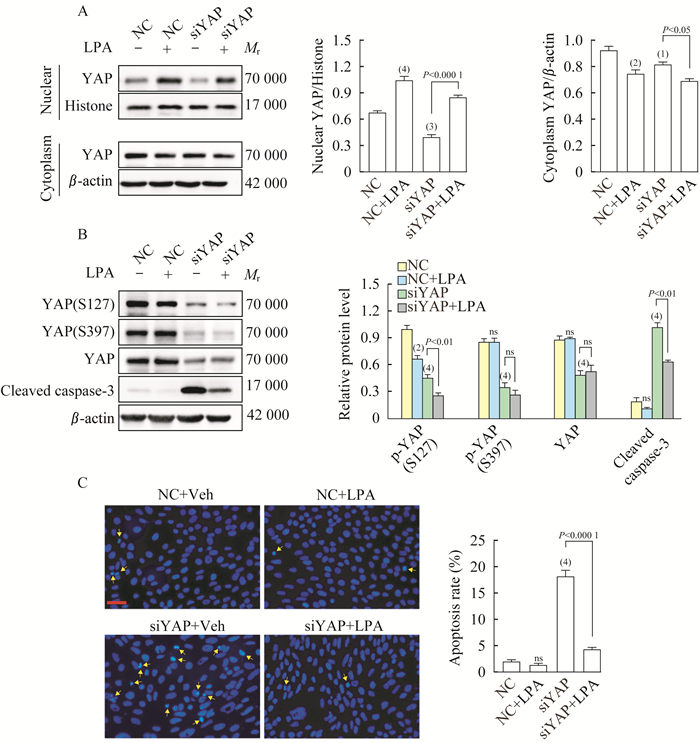
|
| A: Western blot examined YAP protein expression in nuclear or cytoplasm from YAP knocking down podocytes after treatment with LPA, and the level of nuclear histone protein was used as an internal standard, β-actin was used as an internal reference for cytoplasm protein; B: Podocytes were knocked down with YAP-siRNA and treated with LPA, followed by analysis with western blot for examining the expression of p-YAP(S127), p-YAP(S397), YAP and cleaved Caspase-3 (scale bar: 25 μm); C: Hoechst 33258 staining showed LPA decreased podocytes apoptosis in podocytes with YAP knocking down, and apoptotic cells were brightly stained (yellow arrows). vs. NC, (1)P < 0.05, (2)P < 0.01, (3)P < 0.001, (4)P < 0.000 1; ns: Not significant. 图 7 LPA减少了YAP敲减所致的足细胞凋亡 Fig 7 LPA ameliorated the podocytes apoptosis induced by YAP interference |
YAP的核质定位与其功能密切相关,Bonse等[34]首次在足细胞中发现YAP通过其核质定位调控足细胞功能,通过降低ECM刚度或使用达沙替尼抑制YAP的核定位[35]均可促进足细胞中YAP的出核及足细胞凋亡。本团队前期研究发现,在阿霉素诱导所致FSGS小鼠模型的基础上给与YAP抑制剂Verteporfin后,足细胞中总YAP和核内YAP的表达减少,足细胞凋亡增加,FSGS模型小鼠的疾病进展加重[30],阐明了YAP出核是导致FSGS中足细胞凋亡的重要机制。本课题利用阿霉素诱导所致FSGS小鼠模型、阿霉素刺激体外培养的足细胞和FSGS患者的肾活检标本,首先观察到足细胞凋亡在FSGS中明显增加,同时YAP从对照组中的核浆均匀分布转变为FSGS中的持续性出核,YAP失活,这一定位的变化与YAP的磷酸化位点S127和S397水平升高的变化趋势一致,且[p-YAP(S127)+p-YAP(S397)]/总YAP的比值不断升高,提示胞浆内磷酸化YAP的增多和核内非磷酸化YAP的减少;更重要的是,YAP激动剂——LPA可以减少YAP在S127位点的磷酸化从而激活YAP并促进YAP入核,减少足细胞的凋亡,延缓FSGS进展。以上结果不仅验证了YAP活性及定位的变化在足细胞凋亡及FSGS的发生发展中的重要作用,更进一步提出了阻碍FSGS疾病进展的潜在新靶点。
Hippo-YAP通路受到多种内在和外在因素的调节,例如:细胞极性、细胞-细胞连接、可溶性因子、机械信号、细胞代谢状态等[11, 33, 36]。在本课题的体内和体外模型构建中,使用的阿霉素可以引起足细胞足突融合和肾小球硬化[37]。足突融合的足细胞发生骨架变化后,紧密连接减少,可以激活Hippo信号通路,YAP磷酸化增多,YAP失活并滞留在胞浆内[38]。我们在体内外FSGS模型中均观察到了YAP的持续出核,从而使其无法与核内转录因子TEAD结合发挥抑制凋亡和促进增殖的作用,因此随着YAP的出核,足细胞凋亡增多。
LPA是YAP激动剂,与Gα12/13偶联受体相互作用后,通过Rho GTPases诱导肌动蛋白变化,从而抑制LATS1/2激酶活性,使YAP/TAZ激活[33];文献报道LPA可以抑制细胞质中YAP与14-3-3的结合,进而抑制YAP S127位点的磷酸化,激活YAP并促使YAP入核[33]。本实验发现,阿霉素诱导所致FSGS小鼠模型经LPA处理后,FSGS小鼠足细胞中YAP入核增多,活化YAP增多,足细胞凋亡减少。FSGS小鼠经LPA处理后肾小球节段粘连和节段硬化明显减少,而节段性硬化或粘连均与长期肾功能下降相关[39],同时FSGS小鼠经LPA处理后血尿素氮和尿白蛋白/肌酐比较对照组小鼠明显降低,改善了FSGS小鼠的肾脏形态和肾功能,延缓了FSGS的疾病进展。在阿霉素诱导的足细胞损伤模型中,与未处理组相比,LPA处理后的足细胞中p-YAP(S127)表达降低,YAP入核增多,且总YAP表达增多,足细胞凋亡减少,结果提示胞质中失活YAP减少,活化YAP入核增多,减少了阿霉素诱导的足细胞凋亡。此外,YAP敲减导致总YAP和磷酸化YAP均降低,足细胞发生凋亡,经LPA处理后同样出现了p-YAP(S127)表达的降低,YAP入核增多,足细胞凋亡减少。因此,YAP激动剂LPA可以通过抑制YAP在S127位点的磷酸化,促进YAP入核,增加活化YAP,从而减少FSGS中的足细胞凋亡。
YAP(S397)即人们所熟知的YAP(S381),是细胞通过泛素化途径降解YAP的重要分子[16]。我们在阿霉素诱导的FSGS模型中观测到p-YAP(S397)的表达持续升高,首先提示胞浆内进行降解的YAP也在增多。其次,核内YAP在阿霉素处理早期(2 h)短暂升高,之后降低至基线水平以下(8 h),我们认为当阿霉素直接损伤足细胞DNA后,在细胞应激的状态下使得YAP从14-3-3释放,入核短暂增加,此时足细胞未见凋亡;而后阿霉素所造成的细胞连接和骨架的变化使YAP失活出核。再次,[p-YAP(S127)+p-YAP(S397)]/总YAP的比值呈现明显的升高趋势,并且总YAP无明显变化,这就提示可入核的非磷酸化YAP减少,从而促使足细胞发生凋亡。
综上所述,本研究发现了在FSGS中,YAP出核及活化YAP减少促进了足细胞凋亡,LPA能够通过促进FSGS足细胞中YAP的入核,减少细胞凋亡,从而延缓FSGS的疾病进程,为FSGS的疾病治疗提供了实验室基础。但本课题仅聚焦YAP与FSGS中足细胞凋亡的相关性,YAP的上游调控机制及其下游的关键靶基因仍需进一步深入探索。
作者贡献声明 曾明垚 实验实施,数据采集,论文撰写和修改。陈泓儒 实验实施,数据采集,文献调研。齐晨阳,李芳,张志刚 分子生物学实验指导。赵仲华 免疫组化和免疫荧光实验指导。吴慧娟 实验设计和指导,论文撰写和修改。
利益冲突声明 所有作者均声明不存在利益冲突。
| [1] |
FOGO AB. Causes and pathogenesis of focal segmental glomerulosclerosis[J]. Nat Rev Nephrol, 2015, 11(2): 76-87.
[DOI]
|
| [2] |
KITIYAKARA C, KOPP JB, EGGERS P. Trends in the epidemiology of focal segmental glomerulosclerosis[J]. Semin Nephrol, 2003, 23(2): 172-182.
[DOI]
|
| [3] |
D'AGATI VD, KASKEL FJ, FALK RJ. Focal segmental glomerulosclerosis[J]. N Engl J Med, 2011, 365(25): 2398-2411.
[DOI]
|
| [4] |
KITIYAKARA C, EGGERS P, KOPP JB. Twenty-one-year trend in ESRD due to focal segmental glomerulosclerosis in the United States[J]. Am J Kidney Dis, 2004, 44(5): 815-825.
[DOI]
|
| [5] |
KIM YH, GOYAL M, KURNIT D, et al. Podocyte depletion and glomerulosclerosis have a direct relationship in the PAN-treated rat[J]. Kidney Int, 2001, 60(3): 957-968.
[DOI]
|
| [6] |
MEYER T W, BENNETT P H, NELSON R G. Podocyte number predicts long-term urinary albumin excretion in Pima Indians with type Ⅱ diabetes and microalbuminuria[J]. Diabetologia, 1999, 42(11): 1341-1344.
[DOI]
|
| [7] |
PAGTALUNAN ME, MILLER PL, JUMPING-EAGLE S, et al. Podocyte loss and progressive glomerular injury in type Ⅱ diabetes[J]. J Clin Invest, 1997, 99(2): 342-348.
[DOI]
|
| [8] |
WHARRAM BL, GOYAL M, WIGGINS JE, et al. Podocyte depletion causes glomerulosclerosis: diphtheria toxin-induced podocyte depletion in rats expressing human diphtheria toxin receptor transgene[J]. J Am Soc Nephrol, 2005, 16(10): 2941-2952.
[DOI]
|
| [9] |
DAI R, LIN Y, LIU H, et al. A vital role for Angptl3 in the PAN-induced podocyte loss by affecting detachment and apoptosis in vitro[J]. BMC Nephrol, 2015, 16: 38.
[DOI]
|
| [10] |
UDAN RS, KANGO-SINGH M, NOLO R, et al. Hippo promotes proliferation arrest and apoptosis in the Salvador/Warts pathway[J]. Nat Cell Biol, 2003, 5(10): 914-920.
[DOI]
|
| [11] |
MA S, MENG Z, CHEN R, et al. The Hippo pathway: biology and pathophysiology[J]. Annu Rev Biochem, 2019, 88: 577-604.
[DOI]
|
| [12] |
HAO Y, CHUN A, CHEUNG K, et al. Tumor suppressor LATS1 is a negative regulator of oncogene YAP[J]. J Biol Chem, 2008, 283(9): 5496-5509.
[DOI]
|
| [13] |
ZHAO B, WEI X, LI W, et al. Inactivation of YAP oncoprotein by the Hippo pathway is involved in cell contact inhibition and tissue growth control[J]. Genes Dev, 2007, 21(21): 2747-2761.
[DOI]
|
| [14] |
LEI Q Y, ZHANG H, ZHAO B, et al. TAZ promotes cell proliferation and epithelial-mesenchymal transition and is inhibited by the hippo pathway[J]. Mol Cell Biol, 2008, 28(7): 2426-2436.
[DOI]
|
| [15] |
LIU CY, ZHA ZY, ZHOU X, et al. The Hippo tumor pathway promotes TAZ degradation by phosphorylating a phosphodegron and recruiting the SCF{beta}-TrCP E3 ligase[J]. J Biol Chem, 2010, 285(48): 37159-37169.
[DOI]
|
| [16] |
ZHAO B, LI L, TUMANENG K, et al. A coordinated phosphorylation by Lats and CK1 regulates YAP stability through SCF(beta-TRCP)[J]. Genes Dev, 2010, 24(1): 72-85.
[DOI]
|
| [17] |
PAVEL M, RENNA M, PARK SJ, et al. Contact inhibition controls cell survival and proliferation via YAP/TAZ-autophagy axis[J]. Nat Commun, 2018, 9(1): 2961.
[DOI]
|
| [18] |
MARTIN AP, JACQUEMYN M, LIPECKA J, et al. STK38 kinase acts as XPO1 gatekeeper regulating the nuclear export of autophagy proteins and other cargoes[J]. EMBO Rep, 2019, 20(11): e48150.
[DOI]
|
| [19] |
WANG D, HE J, HUANG B, et al. Emerging role of the Hippo pathway in autophagy[J]. Cell Death Dis, 2020, 11(10): 880.
[DOI]
|
| [20] |
ZHAO B, YE X, YU J, et al. TEAD mediates YAP-dependent gene induction and growth control[J]. Genes Dev, 2008, 22(14): 1962-1971.
[DOI]
|
| [21] |
OUDHOFF MJ, FREEMAN SA, COUZENS AL, et al. Control of the Hippo pathway by Set7-dependent methylation of Yap[J]. Dev Cell, 2013, 26(2): 188-194.
[DOI]
|
| [22] |
FENG X, DEGESE M S, IGLESIAS-BARTOLOME R, et al. Hippo-independent activation of YAP by the GNAQ uveal melanoma oncogene through a trio-regulated rho GTPase signaling circuitry[J]. Cancer Cell, 2014, 25(6): 831-845.
[DOI]
|
| [23] |
ZHOU X, WANG S, WANG Z, et al. Estrogen regulates Hippo signaling via GPER in breast cancer[J]. J Clin Invest, 2015, 125(5): 2123-2135.
[DOI]
|
| [24] |
HU X, XIN Y, XIAO Y, et al. Overexpression of YAP1 is correlated with progression, metastasis and poor prognosis in patients with gastric carcinoma[J]. Pathol Oncol Res, 2014, 20(4): 805-811.
[DOI]
|
| [25] |
REGINENSI A, SCOTT R P, GREGORIEFF A, et al. Yap- and Cdc42-dependent nephrogenesis and morphogenesis during mouse kidney development[J]. PLoS Genet, 2013, 9(3): e1003380.
[DOI]
|
| [26] |
HOSSAIN Z, ALI SM, KO HL, et al. Glomerulocystic kidney disease in mice with a targeted inactivation of Wwtr1[J]. Proc Natl Acad Sci U S A, 2007, 104(5): 1631-1636.
[DOI]
|
| [27] |
SCHWARTZMAN M, REGINENSI A, WONG JS, et al. Podocyte-specific deletion of Yes-associated protein causes FSGS and progressive renal failure[J]. J Am Soc Nephrol, 2016, 27(1): 216-226.
[DOI]
|
| [28] |
HUANG Z, ZHANG L, CHEN Y, et al. RhoA deficiency disrupts podocyte cytoskeleton and induces podocyte apoptosis by inhibiting YAP/dendrin signal[J]. BMC Nephrol, 2016, 17(1): 66.
[DOI]
|
| [29] |
HUANG Z, ZHANG L, CHEN Y, et al. Cdc42 deficiency induces podocyte apoptosis by inhibiting the Nwasp/stress fibers/YAP pathway[J]. Cell Death Dis, 2016, 7(3): e2142.
[DOI]
|
| [30] |
ZHUANG Q, LI F, LIU J, et al. Nuclear exclusion of YAP exacerbates podocyte apoptosis and disease progression in Adriamycin-induced focal segmental glomerulosclerosis[J]. Lab Invest, 2021, 101(2): 258-270.
[DOI]
|
| [31] |
CHEN J, CHEN M X, FOGO AB, et al. mVps34 deletion in podocytes causes glomerulosclerosis by disrupting intracellular vesicle trafficking[J]. J Am Soc Nephrol, 2013, 24(2): 198-207.
[DOI]
|
| [32] |
CHEN J, CHEN JK, CONWAY EM, et al. Survivin mediates renal proximal tubule recovery from AKI[J]. J Am Soc Nephrol, 2013, 24(12): 2023-2033.
[DOI]
|
| [33] |
YU FX, ZHAO B, PANUPINTHU N, et al. Regulation of the Hippo-YAP pathway by G-protein-coupled receptor signaling[J]. Cell, 2012, 150(4): 780-791.
[DOI]
|
| [34] |
BONSE J, WENNMANN DO, KREMERSKOTHEN J, et al. Nuclear YAP localization as a key regulator of podocyte function[J]. Cell Death Dis, 2018, 9(9): 850.
[DOI]
|
| [35] |
OKU Y, NISHIYA N, SHITO T, et al. Small molecules inhibiting the nuclear localization of YAP/TAZ for chemotherapeutics and chemosensitizers against breast cancers[J]. FEBS Open Bio, 2015, 5: 542-549.
[DOI]
|
| [36] |
DUPONT S, MORSUT L, ARAGONA M, et al. Role of YAP/TAZ in mechanotransduction[J]. Nature, 2011, 474(7350): 179-183.
[DOI]
|
| [37] |
LEE VW, HARRIS DC. Adriamycin nephropathy: a model of focal segmental glomerulosclerosis[J]. Nephrology (Carlton), 2011, 16(1): 30-38.
[DOI]
|
| [38] |
ZHAO B, LI L, LU Q, et al. Angiomotin is a novel Hippo pathway component that inhibits YAP oncoprotein[J]. Genes Dev, 2011, 25(1): 51-63.
[DOI]
|
| [39] |
许日聪, 曹陶, 徐艺, 等. IgA肾病肾小球节段性硬化或粘连和肾功能下降的相关性分析[J]. 中华肾脏病杂志, 2020, 36(11): 851-857. [DOI]
|
 2023, Vol. 50
2023, Vol. 50


